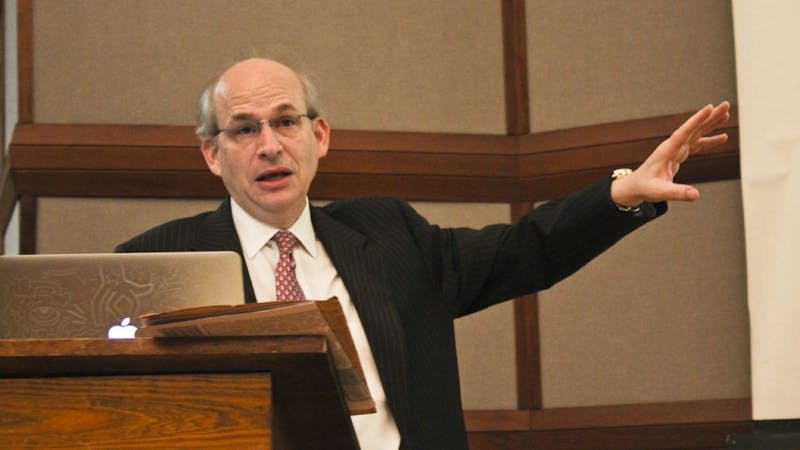NEWS
10/7/14 5:14pm
By Michelle Tran
Seven Rice undergraduate professors from various departments began piloting two different in-class instant student feedback programs, Top Hat and Poll Everywhere, at the beginning of the fall semester. The end goal of these pilot programs is to select a standardized immediate feedback system to be used by professors across campus. Though the official Rice audience feedback brand has been Turning Point for the past five years, professors have individually branched out to implement various other student polling systems, such as iClicker, in their classes. The pilot programs exist due to professors’ expressed interest in moving towards a unified product at the end of last year, according to Carlos Solis, Assistant Director of Academic Technology Services.“Over time, faculty members have started using different products all over campus, and during a meeting with faculty members early last year, there was an expressed desire for standardization,” Solis said. “[They wanted] a product that is more flexible than what we have right now that will add capabilities that will serve instructional purposes of the faculty better.”Solis acknowledged that professors who have already become accustomed to using particular brand products, like iClicker, might have difficulties making a system transition over to Top Hat or Poll Everywhere. However, he said there would be a benefit for everyone to find one product to fit most people’s purposes. “We want to get to the point of standardization where students do not need to be carrying different clickers or applications on their cell phones or using one product in one class and another in one class,” Solis said. Rice IT identified products on the market and narrowed the choices down to Top Hat and Poll Everywhere after considering the systems’ features and reviewing feedback from other academic institutions and Rice faculty members who have previously used them, according to Solis.Having utilized iClicker in his previous classes, Professor of Physics and Astronomy Paul Padley is one of seven professors piloting one of these two programs.“If I just think about my experience as a professor, I would prefer iClicker [over Top Hat],” Padley said. “However, when I imagine the student perspective, I think Top Hat is better because of the [free] cost and the [reduced] burden of students losing their clickers.” Martel College freshman Jorge Whitley has been using Poll Everywhere in General Chemistry I, a class that has previously used iClickers for instant feedback.“Though I see where it might be useful, it seems to be used primarily as a method of taking attendance,” Whitley said. “I think the polling system itself is clean and easy to use. It’s a question with four answer choices and that’s it, but many of the questions asked in the class have more than one right answer, which can be frustrating given the single-response restriction.”If Rice transitioned towards using one of these systems, there would be no additional individual monetary cost for students beyond the single annual payment that the university would make for a site-wide license. According to Solis, the price of this annual payment is yet to be negotiated and will be largely determined by the choice of response system and the final total volume needed as dictated by the quantity of users. Both systems being piloted offer attractive, user-friendly features that add to the range of interactions professors can have with students, Solis said. “With your typical clicker, you can answer ‘A’, ‘B’, ‘C’, ‘D’ or ‘E’,” Solis said. “With these clickers, you can submit full-text answers, so you can have open-ended questions. There is also the opportunity to ask questions using images and point on the parts of the image for the different answers.” The range of interfaces on which these downloadable programs can be accessed gives professors more room to include all students in this immediate-response-mediated learning. “We do a survey at the beginning of the year that lets us know what students are bringing to Rice,” Solis said. “Students are, on average, bringing one laptop plus two to three wireless devices with them.”Sid Richardson College sophomore Sean Dilliard said he has tried multiple forms of feedback programs and is glad to hear that professors are using programs other than iClickers.“Considering the high cost I paid to make use of the technology once, maybe twice in my time during the class, I found the iClickers to be rather impractical,” Dilliard said. “While the use of iClickers is rooted in good intentions, to engage the class and increase interactions with the curriculum, their minimal use at such a high cost offsets most of their good. There are and always have been better alternatives to the clickers; I made use of them in one of my CHBE classes.”According to Solis, Top Hat and Poll Everywhere allow students to use specific applications that they can install on their phone, either iOS or Android. The programs can also be accessed through a browser on a phone, laptop or tablet. Student may also use text services and submit answers via SMS.The opinions of faculty members and students will have weight in the final institution-wide decision, according to Solis. In November, both groups will be invited to attend a presentation made by current professor users who will discuss their experiences with Top Hat and Poll Everywhere. “We feel that if we bring vendors to do a sales pitch to the faculty, we will get always get the rosy picture, and it is important to have the users present their experiences to make decisions based off of real-world usage scenarios rather than vendors’ self-serving interests,” Solis said. “Towards the end of the semester, we also want to survey the students in the classes where these products are being tested.” The IT department would like to act quickly after a faculty and student-driven choice is made. “We would like to have this decision taken care off so that by the fall of 2015 we can move forward with a unified system,” Solis said.




